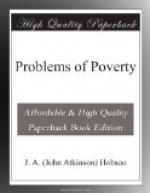Perhaps the most typical form of this socialistic legislation is contained in the Factory Acts, embodying as they do a series of direct interferences in the interests of the labouring classes with freedom of contract between capital and labour.
The first of these Factory Acts, the Health and Morals Act, was passed in 1802, and was designed for the protection of children apprenticed in the rising manufacturing towns of the north, engaged in the cotton and woollen trades. Large numbers of children apprenticed by poor-law overseers in the southern counties were sent as “slaves” to the northern manufacturer, to be kept in overcrowded buildings adjoining the factory, and to be worked day and night, with an utter disregard to all considerations of physical or moral health. There is no page in the history of our nation so infamous as that which tells the details of the unbridled greed of these pioneers of modern commercialism, feeding on the misery and degradation of English children. This Act of 1802, enforcing some small sanitary reforms, prohibited night work, and limited the working-day of apprenticed children to twelve hours. In 1819, another Act was passed for the benefit of unapprenticed child workers in cotton mills, prohibiting the employment of children under nine years, and limiting the working-day to twelve hours for children between nine and sixteen. Sir John Cam Hobhouse in 1825 passed an Act further restricting the labour of children under sixteen years, requiring a register of children employed in mills, and shortening the work on Saturdays. Then came the agitation of Richard Oastler for a Ten Hours Bill. But Parliament was not ripe for this, and Hobhouse, attempting to redeem the hours in textile industries, was defeated by the northern manufacturers. Public feeling, however, formed chiefly by Tories like Oastler, Sadler, Ashley, and Fielden, drove the Whig leader, Lord Althorp, to pass the important Factory Act of 1833. This Act drew the distinction between children admitted to work below the age of thirteen, and “young persons” of ages from thirteen to eighteen; enforced in the case of the former attendance at school, and a maximum working week of forty-eight hours; in the case of the latter prohibited night work, and limited the hours of work to sixty-nine a week. The next step of importance was Peel’s consolidating Factory Act of 1844, reducing the working-day for children to six and a half hours, and increasing the compulsory school attendance from two hours to three, and strengthening in various ways the machinery of inspection. In 1845 Lord Ashley passed a measure prohibiting the night work of women. In 1848, by the Act of Mr. Fielden, ten hours was assigned as a working-day for women and young persons, and further restrictions in favour of women and children were made in 1850 and 1853.




